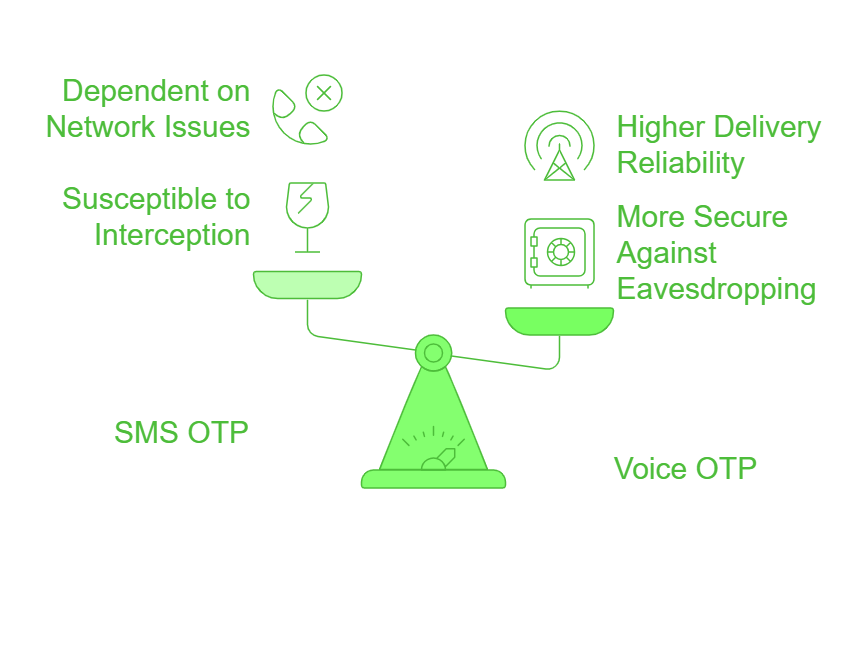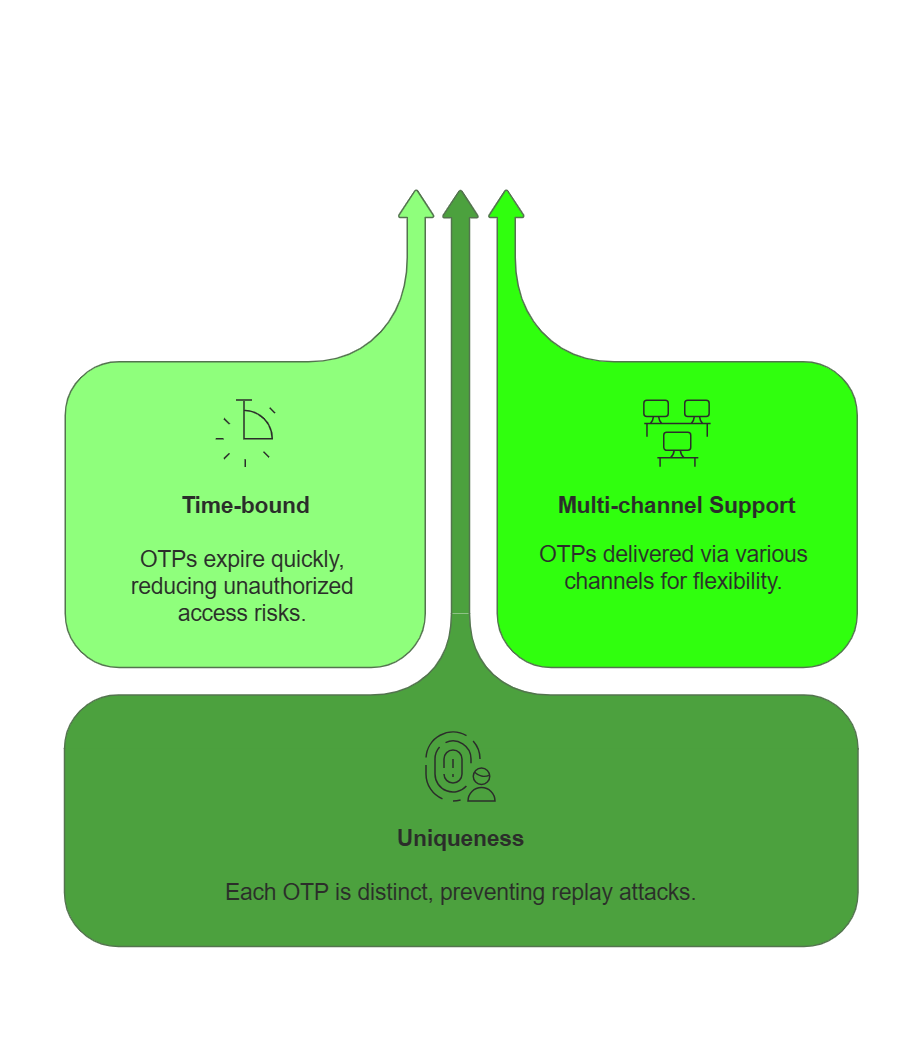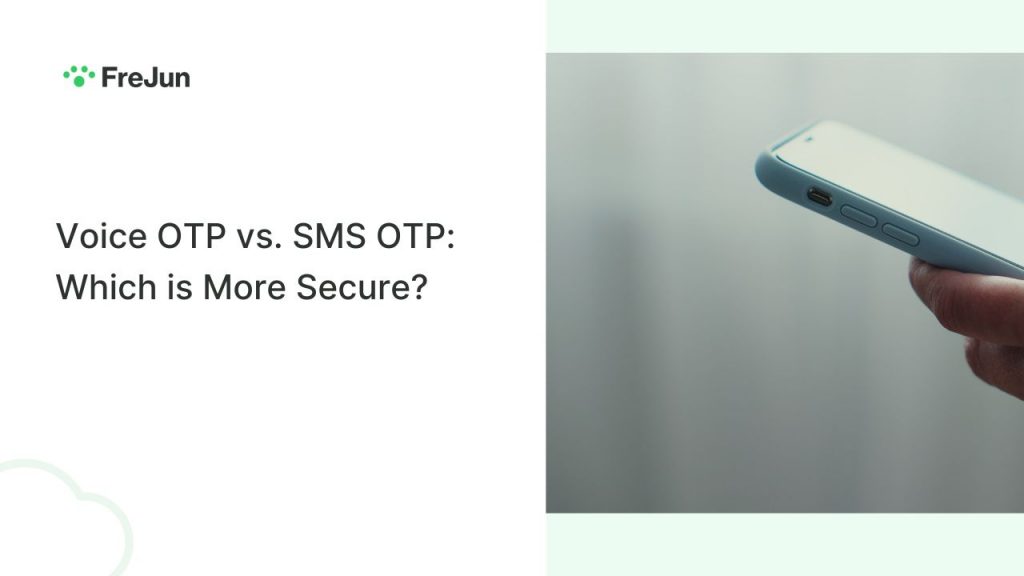Last updated on June 12th, 2025 at 02:19 pm
In today’s digital age, where online security is of paramount importance, one aspect that often comes into play is the use of One-Time Passwords (OTPs). These temporary codes provide an additional layer of protection by verifying the authenticity of users during online transactions or account logins. However, there are different methods for delivering OTPs, with Voice OTP vs SMS OTP being two popular options. But which is more secure? As cyber threats continue to evolve, businesses and individuals need strong authentication methods to safeguard their data and transactions. While SMS OTP (One-Time Password) has been widely used, Voice OTP is emerging as a more secure and efficient alternative. Let’s delve deeper to understand the intricacies and nuances of each method, and weigh their pros and cons to find out.
Table of contents
- What Makes Voice OTP More Secure than SMS OTP?
- Compare OTP Methods
- Understanding OTP: An Overview
- Voice OTP Use Cases Across Industries
- Common Cyber Threats Mitigated by Voice OTP
- Exploring Voice OTP
- Voice OTP vs SMS OTP: Comparing Security Aspects
- Case Studies: Voice OTP vs SMS OTP in Real World Scenarios
- Frequently Asked Questions
What Makes Voice OTP More Secure than SMS OTP?
Voice OTP avoids risks like SIM-swapping and SMS interception by delivering codes through a direct call FreJun enhances this process with robust, secure infrastructure ensuring high delivery success and reduced vulnerabilities.
Compare OTP Methods

Understanding OTP: An Overview
Before we delve into the comparison, let’s first understand what OTP actually is. OTP stands for One-Time Password, which, as the name suggests, is a unique code that can be used only once. It acts as a temporary password replacing the traditional static passwords, preventing unauthorized access and reducing the risk of hacking. OTPs are generated in real-time and expired within a short duration, providing enhanced security.
The Importance of OTP in Security

As cybercrimes continue to rise, it has become crucial to ensure that only authorized individuals have access to sensitive information. OTPs serve as a robust security measure, requiring users to possess something they know (such as a password) and something they receive (the OTP) – a two-factor authentication process that significantly reduces the chances of fraudulent activities.
With the increasing dependency on digital platforms for various activities, such as online banking, e-commerce, and social media, the need for a strong security system has become paramount. Traditional static passwords have proven to be vulnerable to hacking, as they can be easily guessed or obtained through various means, such as phishing attacks or data breaches. In contrast, OTPs provide an additional layer of security by introducing a dynamic element that changes with each login attempt.
1. Time-bound
One of the key advantages of OTPs is their time-bound nature. Unlike static passwords that remain the same until manually changed, OTPs are valid only for a limited period, usually a few minutes. This time constraint adds an extra level of protection, as even if an unauthorized person somehow obtains the OTP, they would have to use it within the limited timeframe to gain access. Once the OTP expires, it becomes useless, further reducing the risk of unauthorized access.
2. Supports multiple channel
Moreover, OTPs can be delivered through various channels, such as text messages, emails, or dedicated mobile applications. This versatility allows users to choose the most convenient method based on their preferences and the security level required for a particular application or service. For example, some users may prefer receiving OTPs via text messages for quick and easy access, while others may opt for email delivery for added security.
3. Unique
Another significant advantage of OTPs is their uniqueness. Each OTP generated is different from the previous ones, ensuring that even if an attacker manages to intercept and capture one OTP, it cannot be reused to gain unauthorized access in the future. This uniqueness adds an additional layer of protection, making it extremely difficult for hackers to bypass the authentication process.
Voice OTP Use Cases Across Industries
| Industry | Primary Use Case |
| Banking & Finance | Secure transactions & fraud prevention |
| Healthcare | Patient identity verification |
| E-commerce | Order confirmation & payment authentication |
| Government | Digital identity verification |
| Telecom | Secure customer authentication |
Common Cyber Threats Mitigated by Voice OTP

Exploring Voice OTP
Voice OTP (One-Time Password) is a secure method that leverages the power of inbound or outbound phone calls to deliver OTPs to users. This innovative authentication process ensures that users can easily and securely verify their identity. Let’s delve deeper into how Voice OTP works and explore its pros and cons.
How Voice OTP Works
The process of Voice OTP authentication is simple yet effective. It begins with the user providing their phone number, ensuring that the system has a valid contact point. Once the phone number is provided, the system generates a unique OTP, which serves as a temporary password for authentication.
Next, the system initiates an automated call to the user’s registered phone number. This call is designed to establish a direct connection between the system and the user. As the call gets connected, an automated voice, carefully programmed for clarity and precision, prompts the user to enter the OTP.
With the automated voice guiding them, the user enters the OTP using the keypad on their phone. This step ensures that the user’s identity is verified, as only they possess the unique OTP. Once the correct OTP is entered, the authentication process is successfully completed, granting the user access to the desired service or platform.
Pros and Cons of Voice OTP
Voice OTP offers several advantages that make it an appealing choice for secure authentication. One of its key strengths is its accessibility. Unlike other authentication methods that rely on smartphones or internet connectivity, Voice OTP can be used by a wide range of users, including those without smartphones or internet access. This inclusivity ensures that everyone can benefit from the added security provided by OTPs.
Another advantage of Voice OTP is its ability to mitigate the risk of fraud. Traditional OTP methods, such as SMS or email, are susceptible to SIM card cloning or hijacking. However, with Voice OTP, the authentication process is conducted through a direct phone call, reducing the vulnerability to such fraudulent activities.
Despite its many advantages, Voice OTP does have a few limitations. One potential drawback is its compatibility with users who have hearing impairments. Since Voice OTP relies on audio prompts, individuals with hearing difficulties may face challenges in hearing and understanding the instructions. This highlights the importance of offering alternative authentication methods to cater to a diverse user base.
Additionally, Voice OTP is reliant on voice recognition systems to accurately interpret and validate the entered OTP. While these systems have significantly improved over the years, there is still a possibility of errors occurring. These errors could potentially lead to failed authentications, causing inconvenience for users. Continuous advancements in voice recognition technology are essential to minimize such occurrences.
Voice OTP is an innovative authentication method that offers a secure and accessible way for users to verify their identity. By leveraging the power of phone calls and unique OTPs, it provides an additional layer of protection against unauthorized access. While it has its advantages and limitations, Voice OTP continues to evolve and improve, ensuring a reliable and convenient authentication experience for users.
Voice OTP vs SMS OTP: Comparing Security Aspects
Now that we understand the working mechanisms and pros and cons of both Voice OTP and SMS OTP, let’s compare their security aspects to determine which method is more secure.
1. Vulnerabilities in Voice OTP
Although Voice OTPs have numerous advantages, they are not immune to vulnerabilities. Attack vectors such as voice recognition errors, call hijacking, or technological limitations can weaken the security provided by Voice OTP. This raises concerns about the potential for unauthorized access.
2. Security Risks in SMS OTP
Similarly, SMS OTPs also have their fair share of risks. They are prone to interception and can be compromised if the user’s mobile device is infected with malware. Moreover, phishing attacks can trick users into providing their OTPs to malicious websites or individuals, resulting in unauthorized account access.
Case Studies: Voice OTP vs SMS OTP in Real World Scenarios
To further understand the security levels of Voice OTP and SMS OTP, let’s explore their applications in real-world scenarios.
Voice OTP in Banking
In the banking sector, Voice OTPs provide an extra layer of security for financial transactions. By verifying the identity of users through their voice, banks can ensure that only authorized individuals can access their accounts. This hampers fraudsters’ efforts to gain unauthorized access, providing enhanced security to customers.
SMS OTP in E-commerce
In the realm of e-commerce, SMS OTPs offer secure verification during online purchases. By validating customers’ identity through their mobile numbers, e-commerce platforms can minimize instances of fraudulent transactions and protect both buyers and sellers. This instills confidence in the overall e-commerce ecosystem.
Ultimately, both Voice OTP and SMS OTP have their own strengths and vulnerabilities. While Voice OTPs might be more secure against some forms of attacks, they may have limitations like inaccessibility for users with hearing impairments. On the other hand, SMS OTPs provide ease of use but are susceptible to interception. The choice between the two methods depends on the specific security needs and preferences of the users.
Regardless of the chosen method, what is essential is the implementation of stringent security measures by service providers and users alike. This includes regular software updates, educating users about potential risks, and employing strong encryption protocols.
Voice OTP and SMS OTP both contribute to enhanced security in the digital realm, each with its own set of advantages and vulnerabilities. By carefully weighing these factors, users and service providers can make informed decisions when it comes to choosing between voice OTP vs SMS OTP.
Conclusion
While SMS OTP has been the traditional choice for authentication, it is becoming increasingly vulnerable to modern cyber threats. Voice OTP offers a more secure, reliable, and user-friendly alternative, ensuring better fraud prevention, accessibility, and efficiency.
For businesses looking for an AI-powered, fraud-proof authentication system, FreJun’s Voice OTP solution is the best choice in 2025. Stay ahead of cyber threats with FreJun’s secure and intelligent voice authentication! 🚀
Further Reading: Critical Skill Sets for Optimal Call Center Agent Teams
Frequently Asked Questions
Voice OTP delivers the code via a call, while SMS OTP sends it as a text — FreJun supports both with reliable systems.
Both are fast, but FreJun ensures voice OTPs are delivered in seconds without network delays.
Yes, voice OTP works even when SMS delivery fails, thanks to tools like FreJun.
Definitely FreJun’s voice OTP avoids SIM-reliant vulnerabilities.
Yes, especially using FreJun’s simple API integrations.
Voice OTP is better for users with low literacy or visual challenges, and FreJun ensures clear delivery.
Voice OTP may cost slightly more, but FreJun offers optimized pricing for bulk use.
Subhash is the Founder of FreJun, the global call automation platform. With 8+ years of entrepreneurial experience, FreJun was established to help customers with their voice communication needs. The goal of FreJun is to develop cutting edge technology and solutions to help customers.
